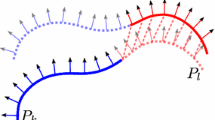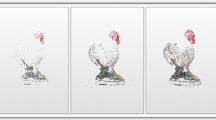Abstract
The aim of the work reported here is to build a useful toolset for 3D model-based vision on an SIMD parallel machine, the AMT DAP. Included in the toolset are facilities for model specification, manipulation and rendering using a ray-tracing approach as well as model recognition and validation using a geometrical-matching approach. In particular, an SIMD parallel version of a ray tracer and an SIMD parallel version of a bottom-up geometrical matcher are described. The ray tracer can render constructive solid geometry models and incorporates spatial subdivision of the scene. The matcher uses edge primitives recovered from scenes to match to model edges using local constraints and deals with spurious data using bin assignments. The overall toolset is illustrated by its use in closed-form testing and refinement, where the models, camera geometry and frame-to-frame motion in an image sequence generated by the ray tracer are known, but are checked and validated using geometrical matching, recognition and localisation.
Similar content being viewed by others
Explore related subjects
Discover the latest articles, news and stories from top researchers in related subjects.References
Appel A (1968) Some techniques for shading machine renderings of solids. AFIPS Spring Joint Comput Conf 32:37–45
Dippe M, Swensen J (1984) An adaptive subdivision algorithm and parallel architecture for realistic image synthesis. Comput Graph 18(3):149–158
Faugeras OD, Hébert M (1983) A 3 D recognition and positioning algorithm using geometric matching between primitive surfaces. Proc Int Joint Conf on AI 8:996–1002
Flynn AM, Harris JG (1985) Recognition algorithmas for the connection machine. Proc Int Joint Conf on AI 9:57–60
Goral CM, Torrance KE, Greenberg DP, Baittaile B (1984) Modeling the interaction of light between diffuse surfaces. Comput Graph 18:213–222
Grimson WEL, Lozano-Pérez T (1984) Model-based recognition and localization from sparse range or tactile data. Int J Robotics Res 3(3):382–414
Heckbert P (1984) The mathematics of quadric surface rendering and SOID. Technical Report TM4, New York Institute of Technology, Computer Graphics Lab
Heckbert P, Hanrahan P (1984) Beam tracing polygonal objects. Comput Graph 18(3):119–127
Holder D, Buxton H (1989) Polyhedral object recognition with sparse data in SIMD processing mode. Image and Vision Computing 7(1):71–78
Kajiya JT (1984) Ray tracing volume densities. Comput Graph 18(3):165–174
Kuchkuda R (1988) An introduction to ray tracing. In: Earnshaw RA (ed) Theoretical foundations of computer graphics and CAD (NATO ASI Series, vol F40) Springer Verlag, Berlin Heidelberg New York, pp 1039–1060
Malhi RK (1990) Parallel Tiling algorithms for visualising solid models. Thesis, Department of Computer Science, QMW College, London, p 104
Murray DW, Cook DB (1988) Using the orientation of fragmentary 3 D edge segments for polyhedral object recognition. Int J Comput Vision 2:147–163
Nishita T, Nakamae E (1985) Continuous tone representation of three dimensional objects taking account of shadows and interreflection. Comput Graph 19:23–30
Pollard SB, Mayhew JEW, Frisby JP (1985) PMF: a stereo correspondence algorithm using a disparity gradient limit. Perception 14:449–470
Quarendon P (1984) WINSOM users guide. Document UKSC 123
Roth SD (1982) Ray casting for modeling solids. Comput Graph Image Proc 18:109–144
Shankar RV, Ramamoorthy G, Suk M (1990) Three dimensional object recognition on the Connection Machine. Patt Recog Lett 11(7):485–492
Slater M (1986) Segments on bit mapped graphic displays. Software-Practice and Experience 16(11):965–980
Usoh M (1992) Parallel process techniques for 3 D model-based vision. Thesis, Department of Computer Science, QMW College, London, pp 118–120
Whitted T (1980) An improved illumination model for shaded display. Comm ACM 23(6):343–349
Williams NS, Buxton BF, Buxton H (1987) Distributed ray tracing using an SIMD processor array. NATO Advanced Study Institute, Il Ciocco, Italy
Author information
Authors and Affiliations
Rights and permissions
About this article
Cite this article
Usoh, M., Buxton, H. Using visualisation as a tool for model-based recognition. The Visual Computer 9, 381–400 (1993). https://doi.org/10.1007/BF01901688
Issue Date:
DOI: https://doi.org/10.1007/BF01901688




